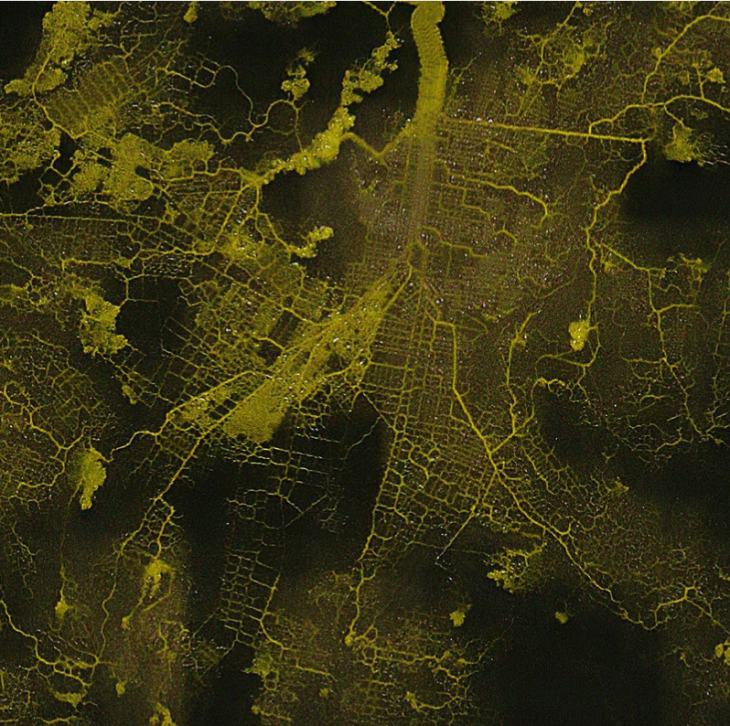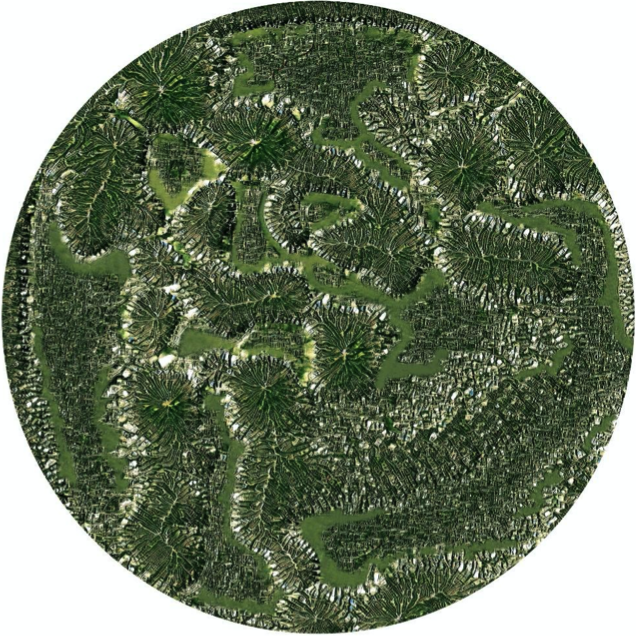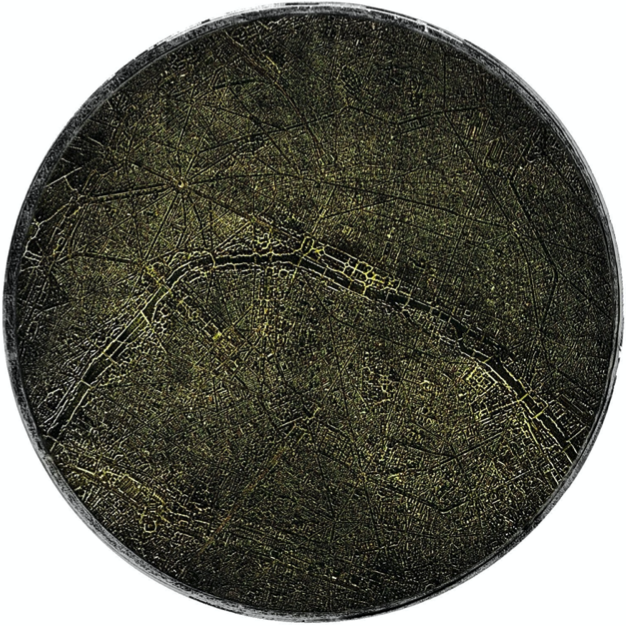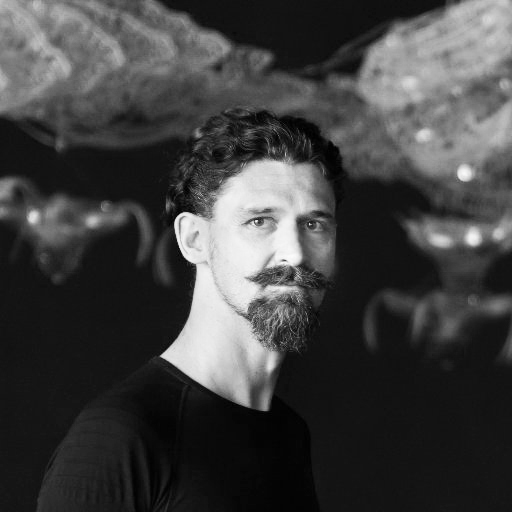VIRAL ECOLOGIES
Protocols of Transmissibility in Urban Design
Seminar Faculty: Marco Poletto and Eirini Tsomokou
“We are prodigious, we are unprecedented. We are phenomenal. No other primate has ever weighed upon the planet to anything like this degree. In ecological terms, we are almost paradoxical: large-bodied and long-lived but grotesquely abundant. We are an outbreak.” – Spillover by David Quammen
 Image Credits: ecoLogicStudio – GAN-Physarum on Guatemala City
Image Credits: ecoLogicStudio – GAN-Physarum on Guatemala City
The current rate of extinctions compared to the geological norm is now several thousand fold faster, making the current one the sixth great mass extinction event in Earth’s history. The start of the Anthropocene in its clearest demarcation, which is to say, we are in a Biosphere catastrophe that will be obvious in the fossil record for as long as the Earth lasts. Evolution itself will of course eventually refill all these emptied ecological niches with new species. (Kim Stanley Robinson, 2020) And if pre-existing plenitude of speciation will take million years to restore, richness and biodiversity within the urban microbiome is already on the rise, including new viral ecologies.
It is a case of what we may call evolution by anthropogenic selection, induced by man, but, ironically, completely oblivious to our existence. To the novel viral ecologies of the contemporary Urbansphere, we are simply carriers, agents in the complex and adaptive networks of viral transmissibility.
This research Seminar will be driven by the following core questions:
– Can we design the urban realm to manipulate its networks of viral transmissibility?
– Can we develop high resolution depictions of the resulting viral ecology?
– And, since we are ourselves an outbreak, can this new perspective on the urban landscape evolve into a systemic urban design methodology for the entire Urbansphere?

Credits: UMLab – Bartlett UCL – Biocoenosis Nest
Transmissibility and virulence. These are crucial parameters. Along with a few other factors they largely determine the gross impact of any outbreak. In cities, neither of the two is an absolute constant; they vary, they’re relative. In the current global pandemic they reflect the connectedness of a virus to us, as human hosts, and to the urban landscape. Transmissibility and virulence measure situations, not just microbes, as infectious disease is inherently an ecological system. Just like human society within our habitat, the global Urbansphere.
The R number, the rate of infection, thus varies seasonally and geographically and, most drastically within the urban realm. Its most accepted formulation is R = ?N/(? + b + v). In this formulation, ? represents the transmission rate. When ? changes R changes. Given the current urgent need to control the COVID19 outbreak computer scientists have begun running localised agent based coronavirus simulations, plotting R at an increased spatial resolution.
The Aim of the Studio will be to answer our 3 core questions by engaging this and other similar simulation models. The main outcome will be a new systemic design protocol of viral transmissibility in London, forging a new vision of the city as a hi-resolution viral ecosystem.

Credits: UMLab – Bartlett UCL – Biocoenosis Nest
Learning Objectives
The course is divided into two parts. In the first part, weekly sessions will guide the students in the acquisitions of dedicated design competencies, software techniques, theoretical frameworks and data acquisition for the London case study.
A month long break will follow. This time will allow students to work individually or in groups towards the formulation of their own design strategy and simulated scenario.
The second and final part will be in the form of an intensive, week long, workshop dedicated to the production of a final exhibition presenting the results of the seminar to the whole school community and invited external guests.
At course completion the student will:
- Be able to deploy algorithmic design techniques at the urban scale with geographic accuracy, geometric precision and human scale resolution to map and visualise networks of viral transmissibility.
- Be able to deploy such algorithmic design techniques to coordinate and consistently visualise a vast amount of data from multiple and heterogeneous sources, including remote sensing, GIS and DEM models as well as other scientific simulation models of viral transmissibility.
- Be able to formulate and visualise novel design strategies for the management of viral transmissibility in the urban realm, including animated or time based narratives.
- Be able to argue for the relevance of such novel design strategies beyond the specific case study of the current COVID19 pandemic in London and towards a systemic urban design framework for future healthy cities globally.
Faculty

Marco Poletto is an architect, educator and innovator based in London.
He is co-founder and Director of the architectural practice ecoLogicStudio and the design innovation venture PhotoSynthetica, focussed on developing architectural solutions to fight Climate Change. In the past 10 years ecoLogicStudio has designed and built several living installations and architectures, demonstrating how microorganisms such as algae can become part of the bio-city of the future.
Marco holds a PhD Degree from RMIT University, Melbourne. His thesis on the “Urbansphere” argues that the increased spatial integration of non-human systems within architecture is crucial to evolve higher forms of urban ecological intelligence. He is also co-author of “Systemic Architecture” a book published by Routledge in 2012.
Marco has been Unit Master at the Architectural Association in London, Visiting critic at Cornell University and Research Cluster leader at The Bartlett. He is currently senior lecturer at University of Innsbruck and the IAAC in Barcelona.
Marco’s work has been exhibited internationally, more recently in Paris (Centre Pompidou, 2019), Tokyo (Mori Gallery, 2019), Vienna (MAK, 2019), Karlsruhe (ZKM, 2019) and Astana (EXPO 2017).
www.ecologicstudio.com
www.photosynthetica.co.uk

Eirini Tsomokou is a London based experienced Architect-engineer and computational designer. She is interested in automation and fabrication as tools to decode and extract morphologies from nature as well as in advanced simulations that will push the boundaries of data-driven design.
She holds an integrated MSc from the School of Architecture in University of Patras and she is a graduate of MSc in Architectural Computation at UCL’s Bartlett School of Architecture.
Eirini is currently working as a computational designer in ecoLogicStudio, as Lecturer assistant in the Synthetic Landscape Lab at University of Innsbruck and as Teaching Fellow for the March of Urban Morphogenesis Design Lab in the Bartlett School of Architecture.
https://www.researchgate.net/profile/Eirini_Tsomokou